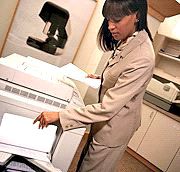Inkjet & Digital Printing
ISO/IEC standard offers guidelines for making IT office equipment friendlier for the elderly and disabled

Tuesday 22. July 2008 - Have you printed your bus schedule today? Sent an e-mail? Made an online payment? At a time when information and communication technology (ICT) is becoming increasingly critical for fulfilling everyday tasks at home and at the office, an ISO/IEC standard will ensure that the elderly and disabled are not left out.
The newly published standard, ISO/IEC 10779:2008, Information technology – Office equipment accessibility guidelines for elderly persons and persons with disability, provides guidelines for the design and evaluation of office equipment to facilitate their operation by persons with the widest range of capabilities, including persons with disabilities or with temporary disabilities.
“It may not be evident for someone with motor difficulties to operate a printer or scanner” says Mr. Atsushi Sakuai, Ambassador of JTC 1 / SC 28. “This can constitute a serious drawback as we increasingly rely on office equipment for completing common tasks such as copying documents, printing data or sending facsimile.”
ISO/IEC 10779 can bring the advantages of information technology to a much wider range of users. This is particularly important as ICT has the potential to substantially improve the lifestyles of older persons and persons with disability e.g. by allowing a person whose mobility is severely impaired, or who has difficulty lifting weights to get his or her job done alone with office equipment.
“Although not all older persons have disabilities,” explains Mr. Sakurai, “the prevalence of disability or limitations is highest among this demographic group. As the percentage of older persons in the worlds population is continually increasing, ISO/IEC 10779:2008 will play a critical role for on one hand ensuring accessibility, and on the other for helping businesses target their products to more users.”
The standard provides guidelines to be used when planning, developing and designing office equipment such as copying machines, page printers and multi-function devices. It outlines specifications for:
operation
display (e.g. auditory)
mechanical operable controls (e.g. position, shapes)
terms (e.g. commonly used expressions), and
maintenance, such as care of equipment and parts replacement by users.
ISO/IEC 10779:2008 also includes provisions for evaluation, feedback and user support requirements.
This International Standard is a joint effort of ISO and the International Electrotechnical Commission (IEC), and should be implemented in conjunction with ISO/IEC Guide 71:2001, Guidelines for standards developers to address the needs of older persons and persons with disabilities.
